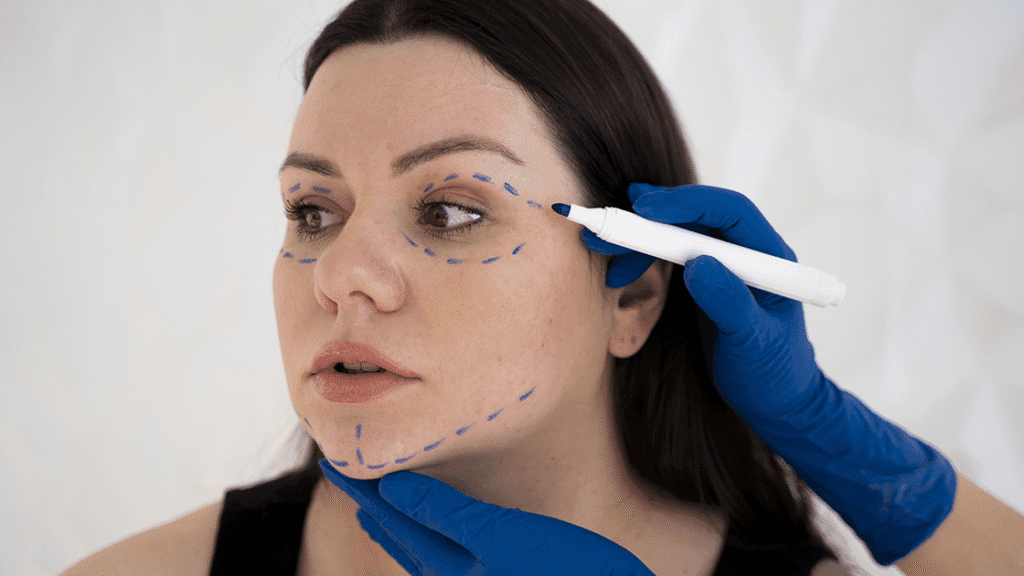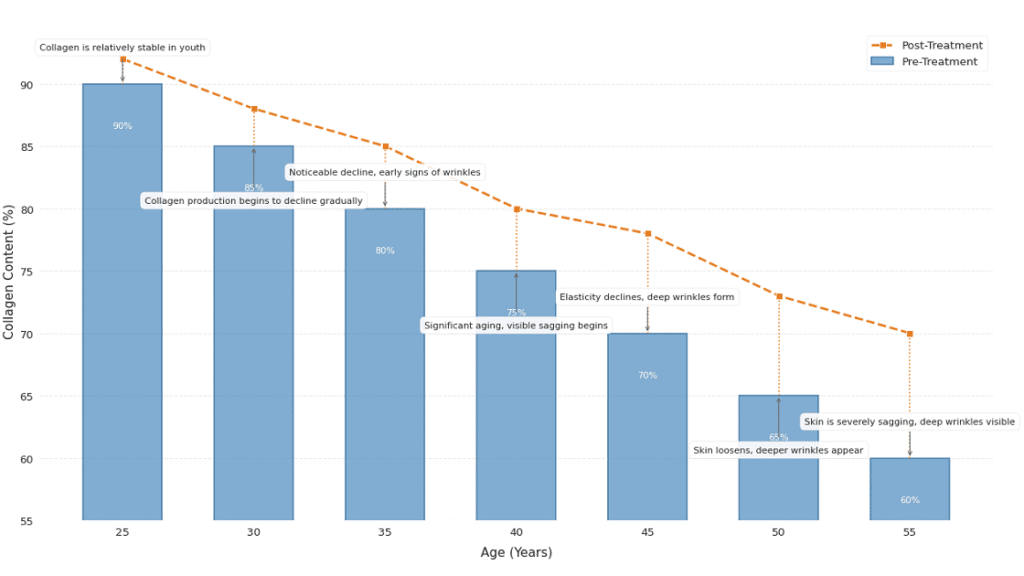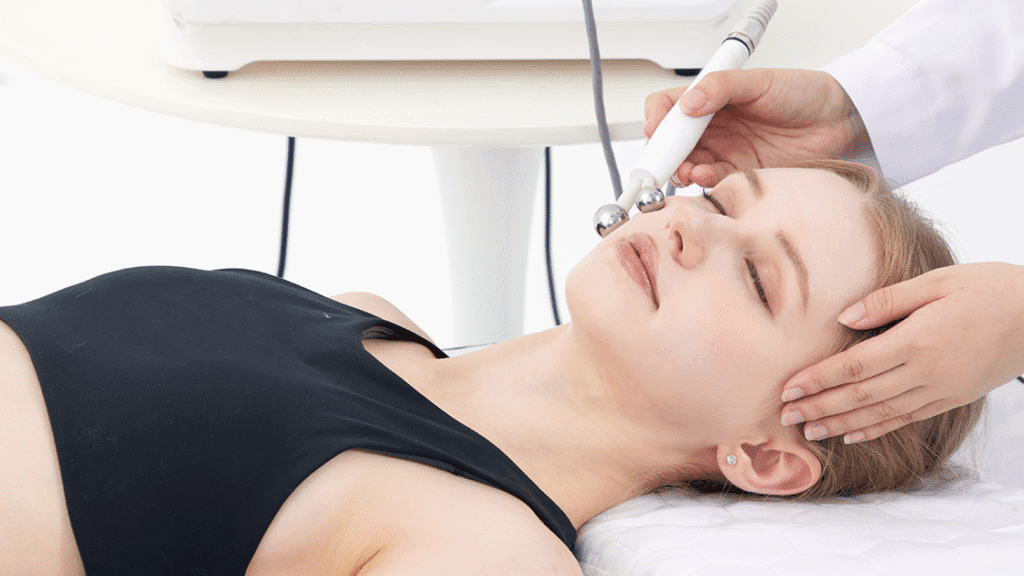In the ever-evolving landscape of aesthetic medicine, radiofrequency (RF) treatments have emerged as one of the most promising non-invasive solutions for skin rejuvenation. As consumers increasingly seek alternatives to surgical procedures, RF technology has gained significant traction for its ability to deliver remarkable results without the downtime associated with invasive interventions. This revolutionary approach harnesses the power of electromagnetic energy to stimulate natural collagen production and address multiple skin concerns simultaneously.
1. Introduction: Understanding RF Treatments and Their Role in Skincare
Radiofrequency (RF) treatments are non-surgical procedures that use electromagnetic energy to heat the skin’s deeper layers, stimulating collagen production. By delivering controlled radiofrequency energy (typically 1-10 MHz), RF targets the dermis and subdermal layers without damaging the surface. This process creates thermal injury, prompting the body’s natural healing response and collagen remodeling. RF treatments induce immediate collagen contraction and encourage the formation of new collagen fibers, which continue to develop over the following months. Modern RF devices feature advanced technology such as temperature monitoring and impedance feedback to ensure optimal energy delivery and patient safety. RF is versatile, treating a wide range of skin concerns, from mild laxity to visible aging signs. In addition to facial rejuvenation, RF also addresses body contouring, cellulite reduction, and certain dermatological conditions, making it suitable for various skin types and needs.
2. Can RF Treatments Replace a Facelift?
The question of whether RF treatments can serve as a viable alternative to surgical facelifts has become increasingly relevant as technology advances and patient preferences shift toward non-invasive options. While RF treatments offer remarkable benefits, understanding their capabilities and limitations compared to surgical interventions is crucial for setting realistic expectations and making informed treatment decisions.
2.1 RF vs. Facelift: The Key Differences
The fundamental distinction between RF treatments and traditional facelifts lies in their approach to skin rejuvenation and the extent of correction they can achieve. Surgical facelifts involve the physical repositioning of facial tissues, removal of excess skin, and tightening of underlying musculature through invasive procedures. This approach can address severe skin laxity, deep wrinkles, and significant volume loss that may not respond adequately to non-invasive treatments. Facelifts provide immediate, dramatic results but require general anesthesia, extensive recovery periods, and carry inherent surgical risks including scarring, infection, and potential complications.
RF treatments, conversely, work through biological stimulation rather than physical manipulation of tissues. They gradually improve skin quality through controlled thermal energy that promotes collagen synthesis and tissue remodeling. This approach is particularly effective for mild to moderate skin concerns and provides natural-looking results that develop progressively over several months. The non-invasive nature of RF treatments means minimal downtime, reduced risk of complications, and the ability to maintain normal daily activities immediately following treatment.

2.2 How RF Can Achieve Facelift-like Results
While RF treatments cannot replicate the dramatic lifting effects of surgical procedures, they can achieve significant improvements that closely mimic facelift results in appropriate candidates. The key to RF’s effectiveness lies in its ability to stimulate deep tissue remodeling and promote skin tightening from within. Radio frequency skin tightening treatments emit radio frequency energy to create controlled injuries in the dermis, leading to collagen and elastin production, improving skin laxity and decreasing the appearance of fine lines and wrinkles. Advanced RF technologies now offer multi-layered treatment approaches, targeting different skin depths simultaneously to achieve comprehensive rejuvenation. Fractional RF microneedling combines the benefits of mechanical stimulation with thermal energy, creating microscopic channels that enhance treatment efficacy while minimizing surface damage. This approach can address textural irregularities, improve skin tone, and provide subtle lifting effects that contribute to a more youthful appearance.
2.3 Pros and Cons of RF Treatments Compared to Facelifts
Pros of RF Treatments:
Non-invasive: No surgery, no general anesthesia, and minimal downtime.
Quick recovery: Patients can return to normal activities immediately after treatment.
Natural-looking results: Gradual improvements that avoid the “tight” look associated with facelifts.
Repeatable: Treatments can be repeated as needed to maintain results over time.
Long-term skin health: Ongoing collagen stimulation promotes continued skin rejuvenation.
Minimal risk: No surgical risks or complications associated with facelifts.
Cons of RF Treatments:
Subtle results: RF provides more gradual, less dramatic changes compared to facelifts.
Not suitable for severe aging: RF may not be effective for significant skin laxity or deep wrinkles.
Multiple sessions required: Several treatments are needed to achieve optimal results.
Maintenance required: Regular treatments may be necessary to sustain improvements.
Gradual results: Results develop slowly over several months, which may not meet expectations for immediate, dramatic outcomes.
2.4 Ideal Candidates for RF Instead of a Facelift
Mild to moderate skin laxity: Best suited for individuals with early signs of aging.
Ages 30s to 50s: Suitable for those experiencing mild skin aging and loss of elasticity.
Good skin quality: Ideal for those with healthy, firm skin who seek gradual improvements.
Realistic expectations: Patients who understand that RF results develop gradually and are more subtle than surgical facelifts.
Preventative care: Those seeking non-invasive treatments to delay the signs of aging.
Post-surgery maintenance: Individuals who’ve had previous facelifts or surgeries and want to preserve results non-surgically.
Busy lifestyles: Ideal for patients who cannot afford long recovery periods and prefer treatments with minimal downtime.
3. Best Age to Start RF Treatments for Preventative Anti-Aging
The concept of preventative aesthetic treatments has gained considerable momentum in recent years, with RF therapy emerging as a leading option for proactive skin maintenance. Understanding the optimal timing for initiating RF treatments can significantly impact long-term skin health and the effectiveness of anti-aging strategies.
3.1 The Power of Prevention: Why Early Intervention Matters
Preventative RF treatments focus on maintaining collagen and elastin before significant skin damage occurs. Collagen production begins to decline around age 25, dropping by 1% per year. By the time visible aging signs appear, structural changes in the skin have already taken place. Early RF intervention helps slow this process by stimulating collagen production, preserving skin firmness, and youthful contours. The advantage of treating younger, healthier skin lies in its ability to produce high-quality collagen and elastin. Younger skin also benefits from better blood circulation, efficient cellular turnover, and faster healing, making RF treatments more effective. Proactively using RF can delay visible aging signs and reduce the need for more intensive treatments later. By maintaining skin quality early on, RF helps preserve a youthful appearance with minimal intervention.

3.2 How RF Delays the Aging Process
RF treatments delay aging through multiple mechanisms that address both immediate and long-term skin health concerns. The thermal energy delivered during treatment stimulates fibroblast activity, encouraging the production of new collagen, elastin, and hyaluronic acid. This process not only improves current skin quality but also creates a reservoir of structural proteins that provide ongoing support against environmental damage and natural aging processes. The controlled thermal injury induced by RF treatments triggers the release of growth factors and cytokines that promote cellular regeneration and repair. This biological response enhances skin metabolism, improves circulation, and strengthens the skin’s natural defense mechanisms against oxidative stress and environmental aggressors. Regular RF treatments can maintain these beneficial processes, effectively slowing the rate of collagen degradation and preserving skin architecture over time.
3.3 When to Transition from Prevention to Correction
The transition from preventative to corrective RF treatments typically occurs when visible signs of aging become more pronounced and require more intensive intervention. This shift usually happens in the late 30s to early 40s, depending on individual factors such as genetics, lifestyle, and environmental exposure. Signs that indicate the need for corrective treatments include deeper wrinkles, noticeable skin laxity, volume loss, and textural changes that no longer respond adequately to preventative measures. The transition period requires careful assessment by qualified practitioners who can evaluate skin condition and recommend appropriate treatment protocols. Corrective RF treatments may involve more intensive treatment parameters, combination therapies, or increased treatment frequency to address established aging concerns. However, even during the corrective phase, maintaining the preventative mindset ensures better long-term outcomes and reduced need for more invasive interventions in the future.
4. Boosting Collagen: Combining RF with PRP for Younger Skin
The synergistic combination of radiofrequency treatments with platelet-rich plasma (PRP) therapy has revolutionized aesthetic medicine by offering enhanced collagen stimulation and superior skin rejuvenation outcomes. This innovative approach leverages the biological healing properties of PRP alongside the thermal stimulation effects of RF technology.
4.1 What Is PRP and How It Enhances RF Treatment?
Platelet-rich plasma (PRP) is an autologous blood product derived from the patient’s own blood through a specialized centrifugation process that concentrates platelets and growth factors. PRP is a concentration of platelets that contains numerous growth factors, cytokines, and bioactive proteins that promote tissue healing and regeneration. When applied to the skin following RF treatment, PRP provides a rich source of growth factors including platelet-derived growth factor (PDGF), transforming growth factor-beta (TGF-β), vascular endothelial growth factor (VEGF), and epidermal growth factor (EGF). The enhancement mechanism occurs through the complementary actions of thermal stimulation and biological augmentation. RF treatment creates controlled micro-injuries that trigger the body’s healing response, while PRP provides concentrated growth factors that accelerate and optimize this healing process. The combination results in more robust collagen synthesis, improved tissue remodeling, and enhanced overall treatment efficacy compared to either treatment modality alone.
4.2 Synergy: Why RF + PRP Is a Powerful Anti-Aging Duo
The synergistic relationship between RF and PRP creates a powerful anti-aging combination that addresses multiple aspects of skin aging simultaneously. The combination of PRP and RF microneedling stimulates collagen and elastin production, leading to firmer, smoother, and more youthful-looking skin, effectively reducing the appearance of fine lines, wrinkles, and acne scars. This dual approach maximizes the skin’s regenerative potential by providing both the stimulus for collagen production and the biological materials necessary for optimal healing. The thermal energy from RF treatments creates optimal conditions for PRP absorption and utilization by increasing blood flow, enhancing cellular permeability, and creating channels for deeper penetration of growth factors. This enhanced bioavailability ensures that the concentrated growth factors in PRP can reach target tissues more effectively, resulting in improved treatment outcomes and longer-lasting results.
4.3 The Benefits of Combining RF and PRP for Skin Tightening
Immediate and long-term results: RF provides immediate collagen contraction, while PRP boosts the formation of new collagen fibers, resulting in lasting skin tightening effects.
Enhanced skin firmness and elasticity: The combination improves skin texture, firmness, and elasticity more effectively than individual treatments.
Clinical evidence: Studies show that patients who undergo RF + PRP treatments experience faster results, fewer sessions, and longer-lasting effects.
Improved skin hydration: PRP’s bioactive components promote hydration and reduce dryness, enhancing skin texture.
Reduced inflammation and better healing: PRP contributes to a reduction in inflammation, promoting faster healing and optimal aesthetic outcomes.
Higher patient satisfaction: The combined approach delivers noticeable, natural-looking improvements that enhance overall skin appearance.
4.4 Ideal Candidates for the RF + PRP Treatment Combo
Comprehensive rejuvenation: Perfect for those seeking a multi-faceted approach to skin rejuvenation, addressing laxity, fine lines, texture irregularities, and volume loss.
Mild to moderate skin aging: Best for individuals experiencing early to moderate signs of aging who want to improve skin quality and prevent further aging.
Good general health: Suitable for patients who are generally healthy and have realistic expectations regarding treatment outcomes and recovery.
Enhancement of previous treatments: Ideal for those who have undergone other aesthetic procedures and wish to maintain or enhance the results.
Preventative anti-aging: Those looking to delay aging signs with a natural, non-invasive treatment.
Natural healing preference: Excellent for individuals who prefer using their body’s natural healing processes, like PRP, over synthetic or foreign substances for skin improvement.
5. RF for Sensitive Skin: What You Need to Know Before Trying
Sensitive skin presents unique challenges in aesthetic treatments, requiring careful consideration of treatment parameters, protocols, and safety measures. RF treatments can be successfully performed on sensitive skin with proper precautions and customized approaches.
5.1 Can RF Be Used on Sensitive Skin?
RF treatments can be safely performed on sensitive skin when proper protocols are followed and treatment parameters are appropriately adjusted. The key to successful treatment lies in thorough patient assessment, customized treatment planning, and careful monitoring throughout the procedure. Sensitive skin types require modified approaches that prioritize safety while maintaining treatment efficacy. Modern RF devices offer precise control over energy delivery, allowing practitioners to customize treatments based on individual skin characteristics and tolerance levels. Temperature monitoring systems and impedance feedback mechanisms ensure that thermal energy remains within safe parameters, reducing the risk of adverse reactions while achieving desired therapeutic outcomes.
5.2 How RF Helps with Skin Conditions like Rosacea and Acne Scarring
RF treatments can provide significant benefits for certain skin conditions commonly associated with sensitivity, including rosacea and acne scarring. For rosacea patients, controlled RF energy can help strengthen capillary walls, reduce inflammation, and improve overall skin barrier function. The thermal stimulation promotes collagen synthesis, which can help repair damaged skin structures and reduce the appearance of persistent redness. In acne scarring treatment, RF energy penetrates to deeper skin layers where scar tissue resides, promoting collagen remodeling and tissue repair. The controlled thermal injury stimulates the body’s natural healing response, encouraging the formation of new, healthy tissue that gradually improves scar appearance and skin texture.

5.3 RF Settings and Customization for Sensitive Skin
Treatment customization for sensitive skin involves careful adjustment of multiple parameters including energy levels, pulse duration, cooling protocols, and treatment intervals. Lower energy settings with longer pulse durations can achieve therapeutic temperatures while minimizing thermal shock to sensitive tissues. Enhanced cooling systems help maintain patient comfort and prevent overheating of superficial skin layers. The treatment protocol may also require longer intervals between sessions to allow for complete healing and recovery. Gradual energy increases over multiple sessions can help sensitive skin adapt to treatment while building tolerance for more intensive protocols. Continuous monitoring of skin response during treatment allows for real-time adjustments to maintain optimal safety and efficacy.
5.4 Safety Tips: How to Ensure a Safe RF Experience for Sensitive Skin
Ensuring safe RF treatment for sensitive skin requires comprehensive pre-treatment assessment, careful treatment planning, and diligent post-treatment care. Pre-treatment evaluation should include detailed medical history, current medications, previous aesthetic treatments, and identification of specific sensitivity triggers. Patch testing may be recommended to assess individual skin response before proceeding with full treatment. During treatment, continuous monitoring of skin temperature, patient comfort, and visible skin changes is essential. Post-treatment care instructions should emphasize gentle skincare routines, sun protection, and avoiding potential irritants during the healing period. Follow-up appointments allow for assessment of treatment response and adjustment of future protocols as needed.
6. Conclusion: Why RF Treatments Should Be Your Go-To Skincare Solution
As the aesthetic medicine landscape continues to evolve, RF treatments have established themselves as versatile, effective, and safe solutions for a wide range of skincare concerns. The technology’s ability to stimulate natural collagen production, improve skin texture, and provide long-lasting results without invasive procedures makes it an ideal choice for modern skincare needs.
6.1 The Versatility of RF: A One-Stop Solution for Your Skincare Needs
RF treatments offer unparalleled versatility in addressing multiple skin concerns through a single technology platform. From preventative anti-aging measures to corrective treatments for established aging signs, RF technology can be customized to meet individual needs and goals. The ability to treat various skin types, conditions, and areas of the body makes RF treatments a comprehensive solution for diverse patient populations. The non-invasive nature of RF treatments allows for integration into regular skincare routines without disrupting daily activities or requiring extended recovery periods. This convenience factor, combined with the technology’s proven efficacy and safety profile, positions RF treatments as an ideal long-term skincare solution.
6.2 Final Thoughts: Is RF the Right Choice for You?
Determining whether RF treatments are appropriate for your skincare needs requires careful consideration of your goals, expectations, and individual circumstances. Consultation with qualified aesthetic practitioners can provide valuable insights into treatment suitability, expected outcomes, and optimal treatment protocols. The gradual, natural-looking improvements achieved through RF treatments make them particularly suitable for individuals seeking subtle enhancement without obvious signs of cosmetic intervention. The long-term benefits of RF treatments extend beyond immediate aesthetic improvements, contributing to overall skin health and resilience against future aging. This investment in skin wellness can provide lasting value and satisfaction for patients committed to maintaining their appearance through advanced, non-invasive technologies.
7. FAQs About RF Treatments
Visible results from RF treatments typically start showing after 2-3 sessions, depending on the individual and the area treated. For optimal results, 4-6 sessions are often recommended, spaced about 2-4 weeks apart. Maintenance sessions may be needed every 6-12 months.
While RF treatments don’t have the same immediate effect as Botox or dermal fillers, they work by stimulating collagen production to reduce fine lines and tighten skin naturally over time. RF is a great complement to Botox for a more holistic approach to rejuvenation.
The effects of RF treatments can last anywhere from 6 months to a year, depending on the individual’s skin condition and lifestyle. Since RF stimulates collagen production, long-term maintenance can help keep skin looking youthful by boosting natural collagen over time.
One of the biggest advantages of RF treatments is that there’s typically no downtime. Most patients experience mild redness or warmth post-treatment, similar to a mild sunburn, which usually fades within a few hours. You can return to regular activities immediately.
Answer: Yes! RF isn’t just for the face. It’s effective for body contouring and cellulite reduction, especially in areas like the abdomen, thighs, and arms. RF helps tighten loose skin, smoothen cellulite, and enhance overall body shape by stimulating collagen production and tightening the skin.








